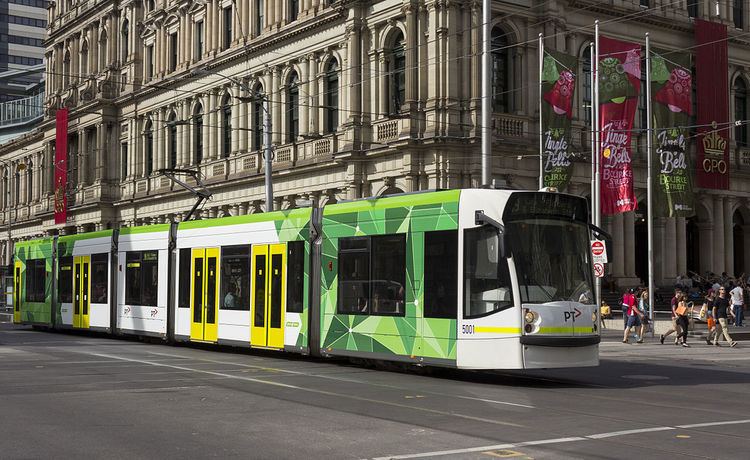Constructed 2002-2004 Fleet numbers 3501–35385001–5021 | Assembly Germany Number in service 59 | |
 | ||
Capacity D1/D2: 32/56 (Seated)D1/D2: 90/130 (Standing) | ||
The D-class trams are low-floor Combino trams that operate on the Melbourne tram network. They were built by Siemens in Germany, and are divided into two classes: the three section D1-class which was introduced between 2002 and 2004, and the five section D2-class which was introduced in 2004. The D-class was procured by M>Tram and have been operated by Yarra Trams since they took control of the entire tram network in April 2004.
Contents
History
Following the privatisation of Melbourne's tram system the private operators acquired new trams to replace Z-class trams. As part of this process, 59 German built Siemens, Combino low-floor trams were introduced by M>Tram at a cost of $195 million.
The first tram arrived for testing in August 2002, and the first four entered service in late 2002. M>Tram operations were transferred to Yarra Trams in April 2004 following negotiations with the State Government after National Express handed the M>Tram franchise back to the government in December 2002.
To aid disabled access to trams from platform stops 'gap eliminators' were fitted to all 59 D-class trams in 2013. Costing $400,000 to fit to the fleet, they are a strip attached to the door step of the trams that prevent the wheels of wheelchairs from getting stuck between the door step and platform. 'Gap eliminators' proved successful in an earlier 2012 trial on two route 96 Ds, before being fitted to all D-class trams.
In early 2013 all 59 D-class trams had their passenger information systems upgraded to announce upcoming stops. The upgrade, which cost $343,000, allows announcements on all routes on which D-class trams regularly travel and their alternative deviations, informing passengers of upcoming stops and connections.
Fatigue Cracking
The bodies of both D1 and D2-class vehicles were found to be developing microscopic cracks in November 2006, which could lead to structural collapse in the event of an accident. This resulted in all 59 Combino trams undergoing structural work to strengthen their frames. The repairs necessitated the removal of between four and eight seats per tram, leaving D1-class trams with 32 seats and D2-class trams with 56.
Variants
D-class trams comes in two variants: the 38 strong D1-class, which have three-sections; and 21 strong D2-class, which have five-sections. The D1-class entered service in late 2002, being operated from Malvern depot, with the last entering service in 2004, while the D2-class entered service in 2004. From 26 July 2004 D2-class trams were progressively moved to operation on route 96, displacing B-class trams that were in service at the time. In 2013, following the introduction of the E-class trams, Yarra Trams started to move D2 class trams to Brunswick depot to operate on route 19.
Currently all D1-class operate from Malvern depot, while all D2-class operate out of Brunswick depot.
Operation
D1-class trams are currently used on the following routes:
D2-class trams are currently used on the following route:
Both D class trams run on the 70a between MCG/Hisense arena and Spencer Street via Flinders Street during special events at Melbourne Olympic Park and/or at the MCG, also they sometimes run on Rt. 57a to the Showgrounds/Racecourse.
In Kaohsiung
In January 2004 a Melbourne D2-class tram operated on a demonstration track in Central Park, Kaohsiung, TAIWAN. The Kaohsiung City Government built the temporary line to demonstrate the concept of light rail.
Criticisms
In March 2016, Time Out Magazine rated the D-Class tram the worst tram on the Yarra Trams network. The reasons behind this was because of a low amount of uncomfortable seats, a loud scream-like sound when the doors open and close resulting in poor ride quality.
